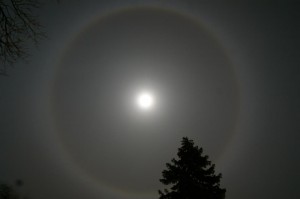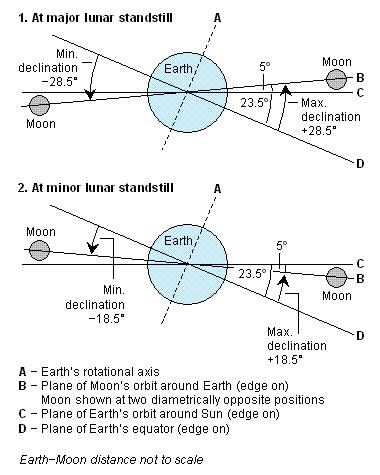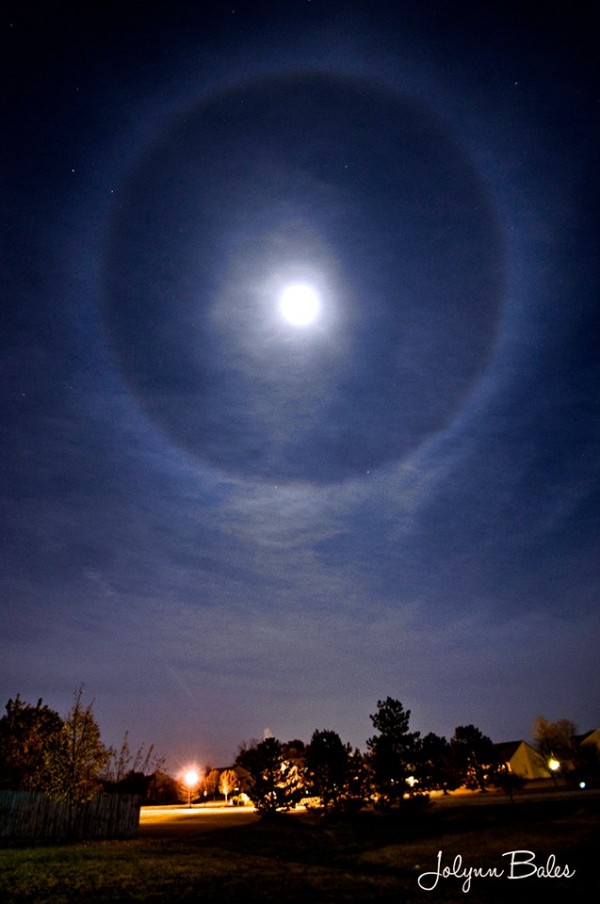Everything you need to know: Hunter’s Moon 2015
The Northern Hemisphere’s full Hunter’s Moon for 2015 falls the nights of October 26 and 27. Will it be bigger, brighter, more colorful?
Hunter’s Moon rising in 2014. Photo by Abhinav Singhai. Visit him on Flickr.
In skylore, every full moon has many names, and most are tied to the months of the year. But some moons are tied to seasons, such as the Harvest and Hunter’s Moons. The Harvest Moon is the full moon closest to the autumnal equinox. The Hunter’s Moon is the full moon after the Harvest Moon. For us in the Northern Hemisphere, the 2015 autumnal equinox came on September 23. The September 27 full moon – night of a total lunar eclipse – was the Northern Hemisphere’s Harvest Moon. So the full moon on October 26 and 27 is the Northern Hemisphere’s Hunter’s Moon.
If you’re in the Southern Hemisphere, your Harvest and Hunter’s moons center on the March equinox, your autumn equinox. Much of what we say in his post – the general information about Harvest and Hunter’s Moons – applies to you, too … next March and April.
The precise time of the October full moon is October 27, 2015 at 12:05 UTC. At North American time zones, that places the time of the full moon in the morning hours on October 27 at 8:05 a.m. EDT, 7:05 a.m. CDT, 6:05 a.m. MDT or 5:05 a.m. PDT. Translate to your time zone here. Thus the October 26 moon – for us in North America – will be just as close to full as the moon you’ll see ascending over the horizon on the evening of October 27.
Click the links below to learn more about the 2015 Hunter’s Moon.
When should I look for the Hunter’s Moon?
What makes a Hunter’s Moon special?
Is a Hunter’s Moon always bigger, or brighter or more colorful?
2015 Hunter’s Moon is a supermoon
How did the Hunter’s Moon get its name?
Minor lunar standstill makes a subtle Hunter’s Moon in 2015
EarthSky lunar calendars are cool! They make great gifts. Order now. Supplies limited.

In autumn, the angle of the ecliptic – or sun and moon’s path – makes a narrow angle with the horizon. Image via classicalastronomy.com.

The narrow angle of the ecliptic means the moon rises noticeably farther north on the horizon, from one night to the next. So there is no long period of darkness between sunset and moonrise, and, around the time of full moon, many people see the moon in a twilight sky. Image via classicalastronomy.com.
When should I look for the Hunter’s Moon? If you’re in the Northern Hemisphere, look for the moon to be bright and full-looking for several nights beginning around October 26 and 27. Around all of these nights, you’ll see a bright round moon in your sky, rising around the time of sunset, highest in the middle of the night. This procession of moonlit nights is what characterizes a Hunter’s Moon.
Want to know the time of moonrise in your location? My favorite source of that information is this Custom Sunrise Sunset Calendar. Once you get to that page, be sure to click the box for ‘moon phases’ and ‘moonrise and moonset times.’
What makes a Hunter’s Moon special? Hunter’s Moon is just a name. It’s the name for the full moon after the Harvest Moon, which is the full moon nearest the autumnal equinox. In the Northern Hemisphere, the Harvest Moon sometimes falls in September and sometimes falls in October. So the Hunter’s Moon sometimes falls in October and sometimes in November.
But the Hunter’s Moon is also more than just a name. Nature is particularly cooperative around the time of the autumn equinox to make the full moonrises unique around this time.
Here’s what happens. On average, the moon rises about 50 minutes later each day. But when a full moon happens close to the autumnal equinox – either a Harvest or a Hunter’s Moon – the moon (at mid-temperate latitudes) rises only about 30 to 35 minutes later daily for several days before and after the full moon.
Why? The reason is that the ecliptic – or the moon’s orbital path – makes a narrow angle with the evening horizon around the time of the autumn equinox. The narrow angle of the ecliptic results in a shorter-than-usual rising time between successive moonrises around the full Hunter’s Moon.
These early evening moonrises are what make every Hunter’s Moon special. Every full moon rises around sunset. After the full Hunter’s Moon, you’ll see the moon ascending in the east relatively soon after sunset for a few days in a row at northerly latitudes.
Is a Hunter’s Moon always bigger, or brighter or more colorful? Hunter’s Moon is just an ordinary full moon with a special path across our sky. Most Hunter’s Moons aren’t really bigger or brighter. They’re definitely no more colorful than any other full moon. Still, many of us do think the Hunter’s Moon always looks bigger … or brighter … and more orange than usual. Why?
It’s because the Hunter’s Moon has a powerful mystique. Many people look for it shortly after sunset around the time of full moon. After sunset around any full moon, the moon will always be near the horizon … because full moons rise at sunset. It’s the location of the moon near the horizon that causes the Hunter’s Moon – or any full moon – to look big and orange in color.
Orange moon near the horizon. The orange color of a moon near the horizon is a true physical effect. It stems from the fact that – when you look toward the horizon – you are looking through a greater thickness of Earth’s atmosphere than when you gaze up and overhead. The atmosphere scatters blue light – that’s why the sky looks blue. The greater thickness of atmosphere in the direction of a horizon scatters blue light most effectively, but it lets red light pass through to your eyes. So a full moon near the horizon – any full moon near the horizon – takes on a yellow or orange or reddish hue.
Big moon near the horizon. The bigger-than-usual size of a moon seen near the horizon is something else entirely. It’s a trick that your eyes are playing – an illusion – called the Moon Illusion. You can find lengthy explanations of the Moon Illusion by googling those words yourself.
Brighter moon than usual? Not in most years, but, in 2015, yes. Keep reading.

The moon’s orbit around Earth is very nearly circular, but not a perfect circle. Sometimes the moon is closer to Earth than at other times. That’s the case with the Hunter’s Moon of 2015. Diagram by Brian Koberlein.
Is the 2015 Hunter’s Moon a supermoon? Yes. It is. That means that, in 2015, the moon’s size and brightness in our sky do come into play.
What is a supermoon? In some months, the full moon is closer to us in orbit than others. The 2015 Hunter’s Moon does happen to be particularly close. It’s near perigee, the moon’s closest point to Earth in its monthly orbit. Perigee comes on October 26 at 13 UTC, less than 24 hours before the crest of the moon’s full phase.
Translate to your time zone here.
Nowadays, people call these close full moons supermoons.
The exact size and brightness of a supermoon in your sky depends on when you see it. The moon will be bigger and brighter on October 26 than on October 27, for example. Considered across a whole month – given the change in distance between the moon’s farthest and closest points – a full moon near perigee can appear as much as 14% larger in the sky and 30% brighter to our eyes than at minimum size and brightness.
That increased size – 14% – might sound significant, but it’s tough to notice with the eye alone. Some very careful observers say you can discern the extra-large size of a full moon at perigee. But most of us can’t. The effect is too subtle.
On the other hand, a supermoon does often look brighter to the eye – by a noticeable amount – than an ordinary full moon. So notice how brightly the moon is shining, especially on October 26!
How did the Hunter’s Moon get its name? We hear many, many different explanations for the name Hunter’s Moon.
Perhaps the most common one centers on the shorter-than-usual time between moonrises around the full Harvest and Hunter’s Moons. Now matter which hemisphere you’re in, every autumn, there’s no long period of darkness between sunset and moonrise for several days in a row, around the time of full moon. In the days before tractor lights, the lamp of the Harvest Moon helped farmers to gather their crops, despite the diminishing daylight hours. As the sun’s light faded in the west, the moon would soon rise in the east to illuminate the fields throughout the night. A month later, after the harvest was done, the full Hunter’s Moon was said to illuminate the prey of hunters, scooting along in the stubble left behind in the fields.
Who named the Harvest and Hunter’s Moon? Those names probably sprang to the lips of farmers and hunters throughout the world, on autumn evenings, at times of the full moon.
Bottom line: The Hunter’s Moon for the Northern Hemisphere in 2015 comes on the nights of October 26 and 27. The Harvest Moon is the full moon closest to the autumnal equinox, which in 2015 came on September 23. The Hunter’s Moon is the next full moon after the Harvest Moon. Learn the lore of the Hunter’s Moon – and what to look for – here.
When is the next Blue Moon?
Thanks to: http://earthsky.org






 Sat Mar 23, 2024 11:33 pm by globalturbo
Sat Mar 23, 2024 11:33 pm by globalturbo

 Courtesy U.S. Naval Observatory
Courtesy U.S. Naval Observatory 










